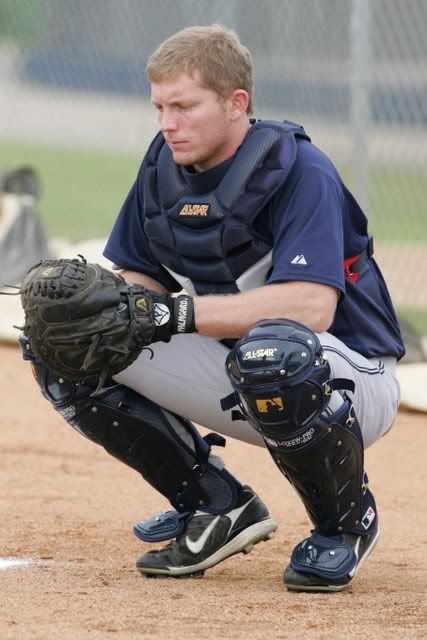 Indians Archive
Indians Archive  Wagner Finishes Strong At Akron
Wagner Finishes Strong At Akron
 Right-hander Neil Wagner put up a great showing down the stretch this season.
Right-hander Neil Wagner put up a great showing down the stretch this season.
After starting the year at advanced Single-A Kinston and putting up an 8.73 ERA in nine April appearances, Wagner settled in the rest of the way to put up a 3.44 ERA in 32 appearances from May until mid-August when he was called up to Double-A Akron. At Akron he was sensational in limited time going 2-2 with a 2.75 ERA in 11 combined appearances in the regular season and playoffs. Wagner's late season progress was a byproduct of him sticking to his plan as well as some tinkering with his delivery.
"I don't know, I just kind of had a bad start this season the first month or month and a half," said Wagner last week at Canal Park in Akron. "I just kept sticking to it and made a couple adjustments, my windup being one of them. I lowered my arm slot just a little bit and started throwing more strikes and kind of brushed off the bad outings as much as I could."
Wagner now throws exclusively from the stretch, which was a change implemented by Kinston pitching coach Greg Hibbard earlier in the year. Wagner used to always throw from the windup with no one on base, but the change was made in mid-May to strictly throw from the stretch. While it took some time to adjust to the change, his performance took off from there.
"Hibbard said that my velocity was better out of the windup, but my velocity was kind of a little inconsistent so we tried it for a couple weeks and if I liked it we would stick with it," said Wagner. "As I settled into it my velocity out of the stretch got back to where it was out of the windup. I was just more consistent with the release point on all my pitches and decided to stay with it."
The Indians drafted Wagner in the 21st round of the 2005 Draft out of North Dakota State University. Wagner closed in college, and has the stuff to be a late inning reliever. Outside of right-handers Adam Miller and Mike Pontius, Wagner arguably has the most explosive fastball in the system and shows good command with it. Wagner's fastball velocity out of the stretch is still up at 95-96 MPH, and earlier in the season topped out at 98 MPH and in Akron's first playoff outing was at 97 MPH.
While Wagner controls his fastball well and can blow it by hitters, the key to him becoming a bona fide relief prospect will be the development of at least one secondary pitch which he has struggled with at times. He throws a slider and changeup, and was sent to the Hawaii Winter League last offseason to work on them. The results have been mixed to date, and he continued working on developing the pitches this season and will continue to do so this offseason in the Arizona Fall League.
"I am working on a slider and I guess a split-changeup," said Wagner. "It drops kind of like a splitter but is not a true splitter. The main thing with my slider and changeup is to throw them for strikes and be a little more unpredictable early in the count so that late in the count I can use my fastball or those pitches so guys are not sitting on fastball every pitch. The split-changeup got better sort of in the middle of the season and toward the end of the season it picked up where I was not only just throwing it for strikes but throwing it in the right counts and right situations to be more unpredictable with what I was throwing. It was not so much throwing it for strikes, it was just using it in correct counts."
There is no doubt the Minnesota native's strong finish has firmly added himself to a list of impressive relief pitching prospects the Indians are starting to pile up in the system. His outstanding month of August and showing in the playoffs here in September have provided him the springboard he needed going into next season where he should start in the Akron bullpen.
"The last month of the season was good coming up [to Akron] and getting my feet wet at this level," said Wagner. "Knowing I can command three pitches and use them in different counts has really given me some good confidence moving forward. I hope to have a good fall league and offseason and go from there."
Juhl Adjusts To Backup Role
Indians minor league catcher Brian Juhl is what you would call an organizational soldier. A player who has little chance of making it to the big leagues or even to Triple-A, but still important where he provides depth and fills a need at catcher in the middle levels of the system. As an organizational player, the playing time can be a bit sporadic, especially for a backup catcher. Through it all Juhl has kept a positive attitude and adjusted to not only the limited playing but also the transition to the professional ranks.
has kept a positive attitude and adjusted to not only the limited playing but also the transition to the professional ranks.
"To be honest, playing time [was] hard to come by," said Juhl in a recent interview. "But I almost expected it my first year with just learning the ropes and seeing how I fit into the organization. It is pretty tough showing up at the field everyday as it is different from college in that you show up everyday and your sole concentration is baseball. What can you do to get better that day and what can you do to help your team. It has kind of been an adjustment with the wood bat, and also the toll just being out there everyday takes on your body. Some days you wake up and you are like ‘oh man', and I [didn't] even play everyday."
Juhl was a 35th round pick out of Stanford University in the 2007 Draft. He did not sign until mid-July in 2007 and had limited playing time that year at Single-A Lake County where he played in just 21 games and hit .235 with 1 HR, 7 RBI and a .681 OPS. In a backup role in advanced Single-A Kinston this year Juhl only played in 41 games and hit .240 with 3 HR, 21 RBI and a .737 OPS.
Juhl, who resides in the Houston, TX area, started his season way back in spring training around mid-February when he was one of the first players to report to camp. During his time in spring training and all throughout the season Juhl worked a lot on his throwing. Minor league catching coordinator Tim Laker worked with Juhl several times in spring training and throughout the season, and Juhl made progress.
"I was not throwing that well when I got to spring training, so we worked on that a little bit and I started to throw a lot better [by the end of the season]," said Juhl. "The catchers work with [Chris] Tremie (Kinston manager) a lot too, so we work on footwork and our exchange. Specifically I worked on some follow through things with Laker where I was not using my lead arm very well. If you use [the lead arm] well you can get a little more carry on the ball."
Juhl needs more work as a hitter, but as a backup the opportunities to get regular at bats is challenging. As a result, Juhl had a lot of time for cage work and with two to three games before his next appearance in a game he had ample time to dissect his approach at the plate.
"For me, the biggest thing was just being ready to hit," said Juhl. "A lot of times, especially if you have not hit in awhile, you try to go up there and get comfortable. Sometimes you don't have that luxury, especially [at this level] where guys can throw a lot of pitches for strikes. A lot of times getting down 0-1 you are almost playing into the pitcher if you don't hit the pitch you wanted to hit. I am [worked on] getting myself ready to go up to the box and hit the first pitch but stay within my approach. Also to stay relaxed at the same time too."
It will be interesting to see what Juhl's fate in the organization is this offseason. The Indians have an abundance of catching prospects, so much so that Juhl himself and other fellow catchers taken in the 2007 Draft like Doug Pickens and Michael Valadez will be on the bubble to stick in the organization when camp breaks next spring. Juhl is the most advanced of the three, and played at a higher level this season, so he has that going for him.
Photos courtesy of Tony Lastoria, Akron Aeros and Ken Carr
- NBA Announces 2013-2014 Schedule
- Browns Ink Sharknado
- Sharknado A No-Show For Rookie Camp
- Trent Richardson Out Until Training Camp
- Browns Sign Brandon Jackson
- Carrasco Suspended Eight Games
- Browns Add to Wide Receiver Depth with David Nelson
- Browns Need to Learn from Past Draft Mistakes
- Browns Release Chris Gocong and Usama Young
- Browns Missing on Grimes Disappointing, But Not The End
The TCF Forums
- Official- Browns Coach Search/Rumors
Nicastro13 (Tuesday, January 21 2014 11:45 AM) - Chris Grant's first 3 drafts
Kingpin74 (Tuesday, January 21 2014 10:13 AM) - The 2014 Offseason Thread
googleeph2 (Tuesday, January 21 2014 9:36 AM) - 2015 Recruiting
furls (Tuesday, January 21 2014 6:57 AM) - Mike Brown
YahooFanChicago (Monday, January 20 2014 11:15 PM) - Movies coming out
HoodooMan (Monday, January 20 2014 9:34 PM) - 2014 Hoops Hockey Hijinx
jpd1224 (Monday, January 20 2014 4:44 PM) - 2014 Recruiting
jclvd_23 (Monday, January 20 2014 2:26 PM) - Wish List - #4 Pick
Hikohadon (Monday, January 20 2014 1:26 PM) - #1 overall pick Anthony Bennett
TouchEmAllTime (Sunday, January 19 2014 1:28 PM)


